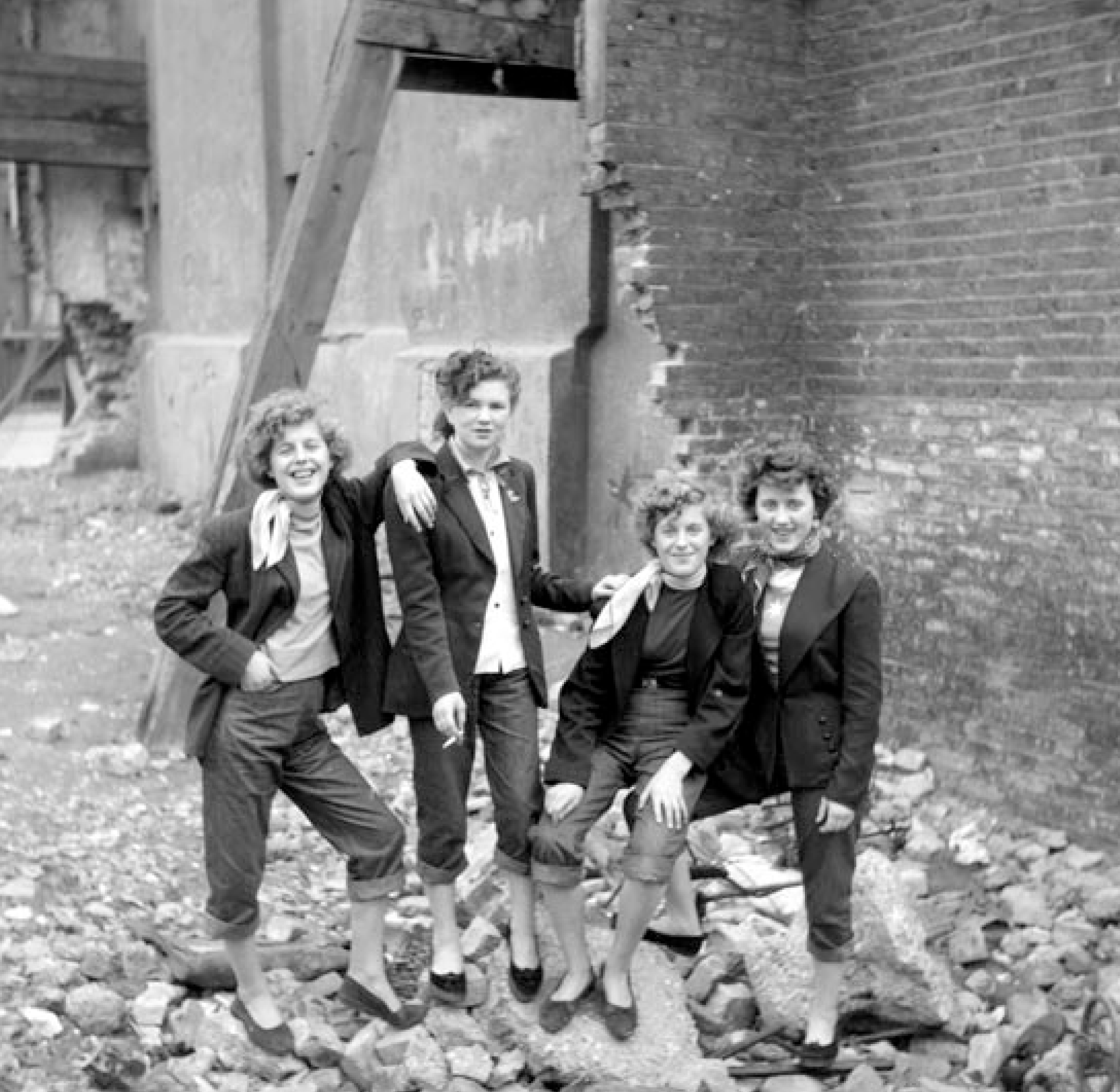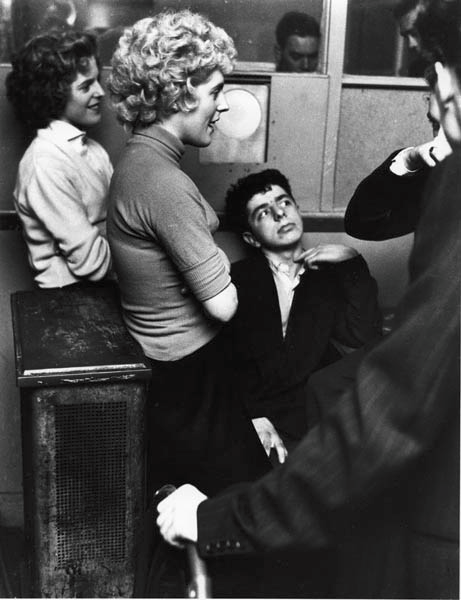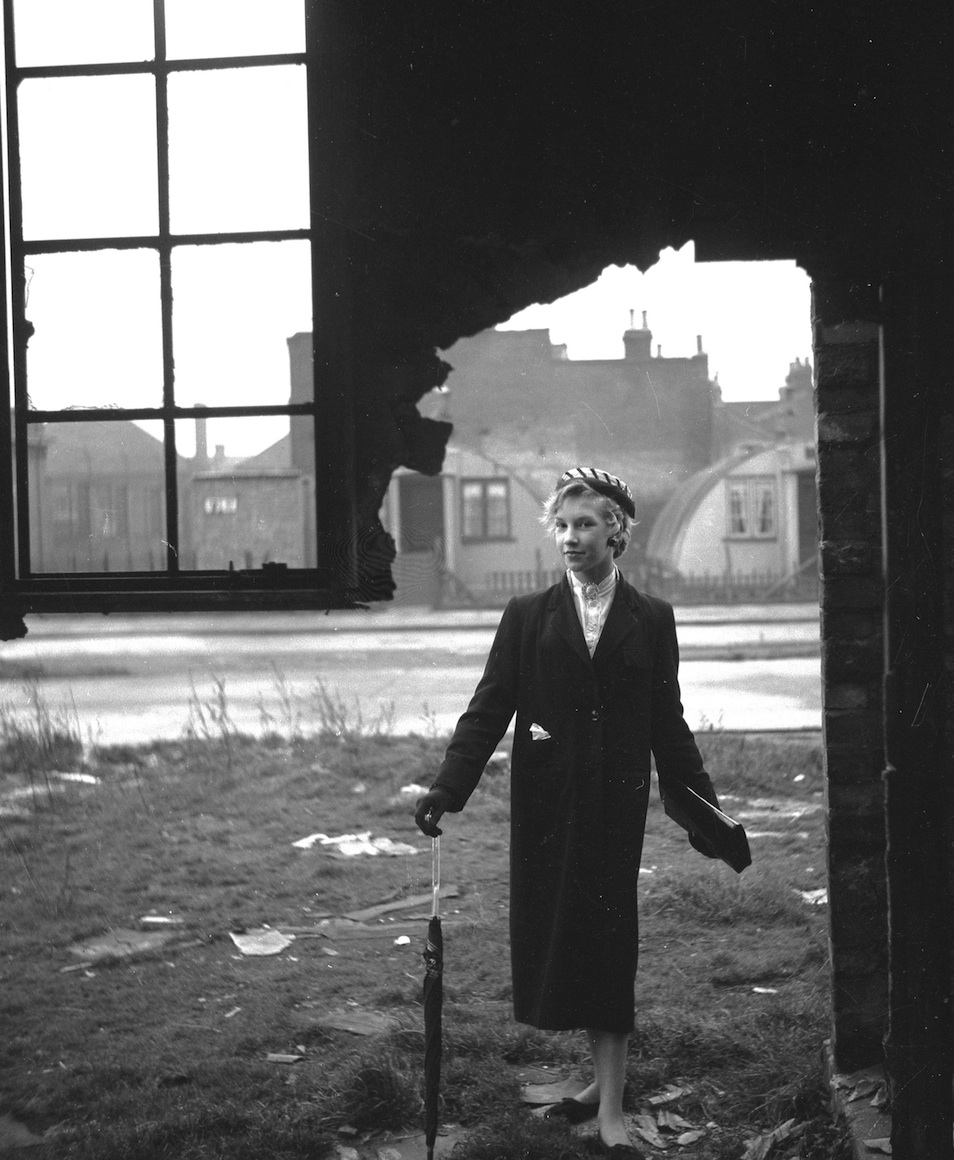Writer and Teenage Blog reader Eve Dawoud saw our previous post on Teddy Girls and wanted to share with us selections of interviews she’s conducted with some of the real people in the photos — Mary Toovey, Elsie Hendon, Iris Thornton and Ted Burton — for an ongoing research project. So here we have it, letting the words of the Teddy Girls take center stage for the third post in our London youth culture series in connection with our UK premiere at the BFI London Film Festival. Click here for more information on screening dates and tickets.
Mary Toovey: Turn up jeans, a coat and something to tie around your neck, those were the Teddy Girl essentials. My friends and I would buy similar clothes when we shopped on the Portobello Road. It was all second hand then, we couldn’t afford new. Smart’s, the local pie and mash shop on Goldborne Rd, was where we went to eat out if we had the money. Me and Jean Rayner, lived in Edenham Street. Elsie and Rosie Hendon, who were identical twins, lived on the next road along in Southam Street. I met them in primary school.
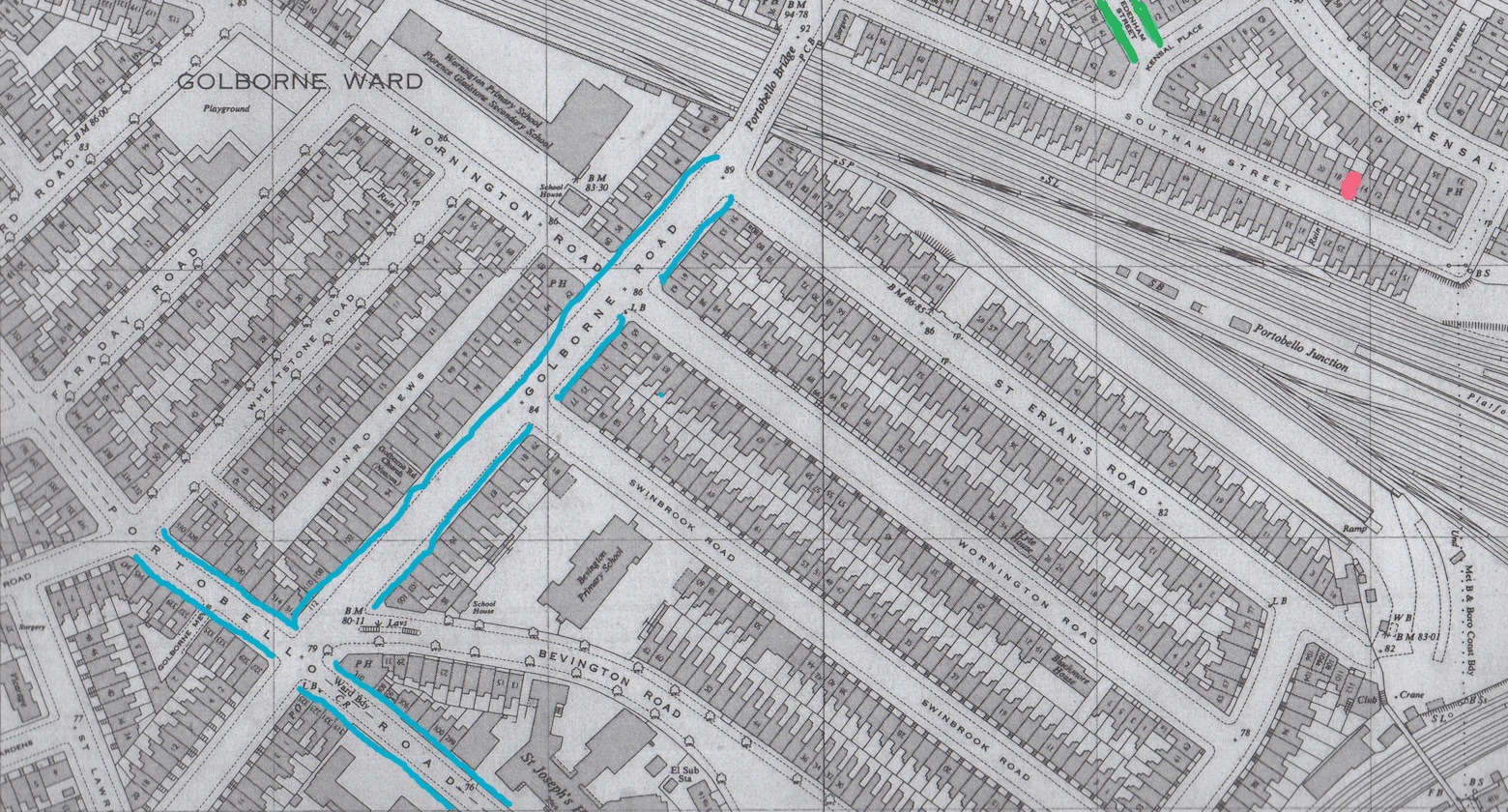
North Kensington
I am 15 in the photos and had already left school for my first job, which was at Kegoo’s compact factory. We didn’t wear much make up ourselves though. Hair was important. Always short hair. We had quiffs as well, like the boys. Later that year Rosie dyed my hair blonde. I was frightened because my dad would have killed me so I wore a turban around him to cover that up!
We grew up playing on these bombsites, and we still hung out there when we were teenagers. After dark we would go to the local youth club the Seven Feathers to dance with the boys or a house party, someone would play an old piano. We didn’t have much, it wasn’t long after the war, which my dad fought in.
Rosie and I used to go to the pictures (cinema). One day I got chatting to a boy, 3 years later, aged 18, I married him. We have been together ever since.
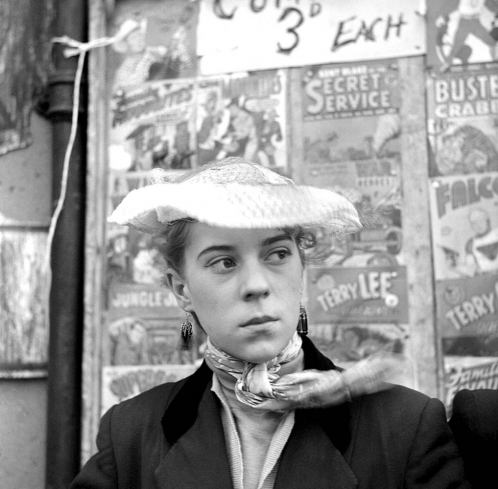
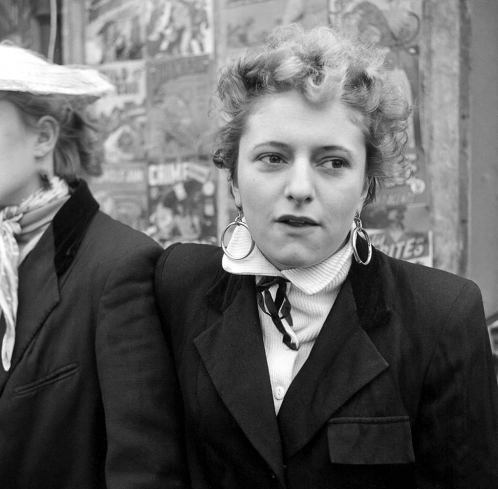
Rosie Hendon: We did have a different look, a style that we made up. I lived in the house directly on the right of this bombsite which used to be number 14 Southam Street, the photographer Roger Mayne also used to come take photos of us. He did a series about Southam Street and we are in some of those photos too. I was always buying clothes, I was terrible. You’d share clothes too, with your friends and sisters, used to borrow the boy’s jackets sometimes.
Seven Feathers Club by Roger Mayne
There were so many factories in the local area most of which I worked in. McVities biscuits, Heniz baked beans, the wage was £2 a week. It was mainly girls in the factories, boys would work on the building sites or as apprentices. We would all go to Jean Rayner’s house and do our hair in the basement. The Duck’s Arse was a popular style, or you would backcomb your short hair into a style called the Cottage Loaf. The boys had the Elephant Trunk.
On Portobello market there were stalls selling where we would get our short sleeve blouses with high collars, brand new jeans and Cameo brooches, they were new reproductions, not second hand. We tried not to wear second hand, because you had to get the boys you know. They were very smart, the boys, walking up and down, we had to do something for them to meet our eye.
My cousin Ted Burton he had a record player and we’d all listen to music and dance around his house, telling him what records to play!
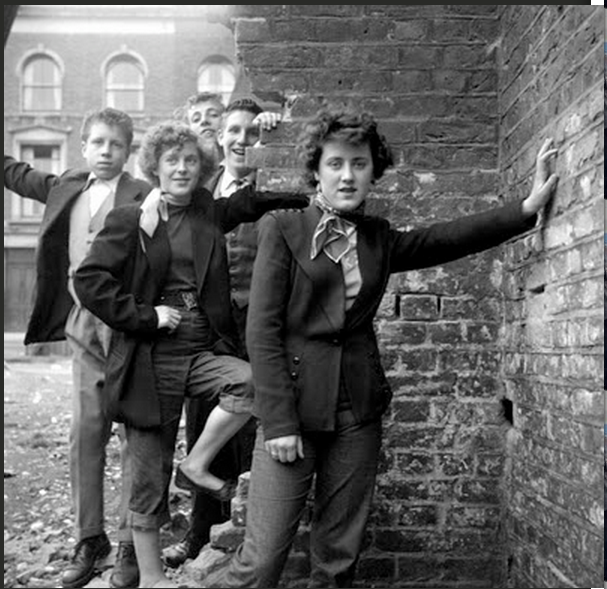
Ted Burton: My two brothers and I were proud owners of a radiogram bought on hire purchase. I had all the good 78s. Rosie and her friends used to come round and sit on my doorstep on their lunch breaks. They’d say put that one on Ted, play this one… we listened to Tony Bennett, Frankie Laine, Johnny Ray, Guy Mitchell, Eddie Fisher, Al Martino, Dickie Valentine, Ronnie Hilton, Doris Day, Rosemary Clooney, Teresa Brewer, Connie Francis, Lita Rosa and Joan Regan.
With the arrival of the jukebox came rock ‘n’ roll. Elvis, Gene Vincent, Bill Haley and the Comets, Fats Domino, Little Richard and Jerry Lee Lewis. We soaked up the American vibe. Scotties Milk Bar on Harrow Road was an American style ice cream parlour where we would go to enjoy banana splits, peach melba and knickerbocker glory’s.
The Black Cat Coffee Bar on Maryland Rd was a very popular place for us all to meet for coffee, tea and soft drinks the big attraction here was the jukebox- no room for dancing much but obviously nodding in time to music and chatting up the opposite sex much in evidence. I remember hearing Big Joe Turner- Shake Rattle and Roll for the first time there.
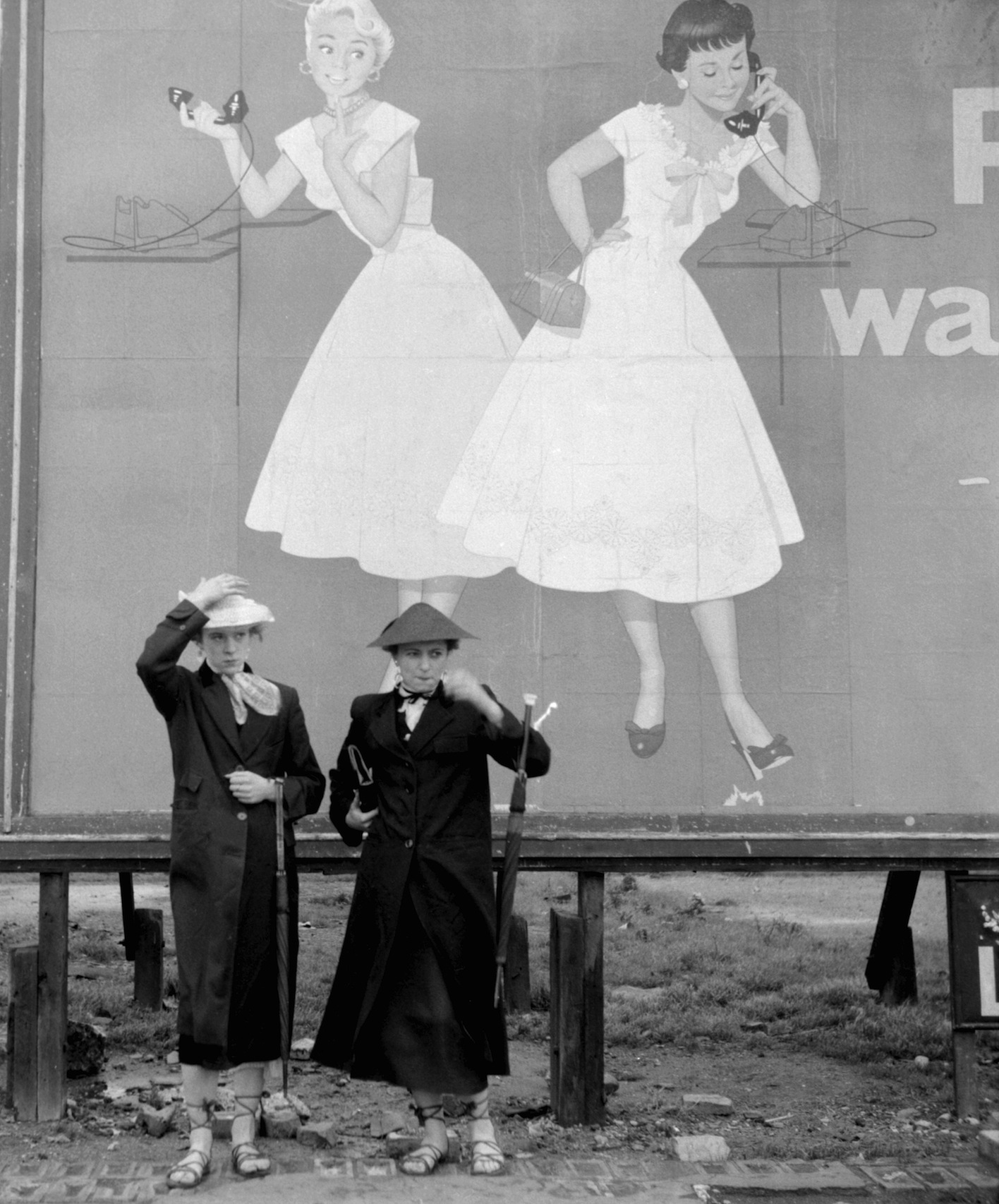
Iris Thornton and Pat Wiles
Iris Thornton: When I was 13 I started going to the Mayflower youth club every day after school. You could take classes in deportment and cookery, there was a hairdressers and sports activities to get involved in. One day, 2 years later, Ken Russell came and asked if there were any Teddy girls there to photograph. There weren’t many Teds in my area, just a few of us so we turned heads. You would walk past people on the street and hear them saying ‘Oh god, look at what they are wearing!’ Which made me chuckle.
The photos were taken where I lived in Canning Town, this area was called the Docklands Settlement. I lived at home with my parents and older sister and brother, it was a prosperous working class area because of the docks on the River Thames. In 1955 I left school and went to work with my sister in a factory. At the time I was happy to leave, thought it was marvellous. But then after a little while I wished I has still been in school, work was so boring.
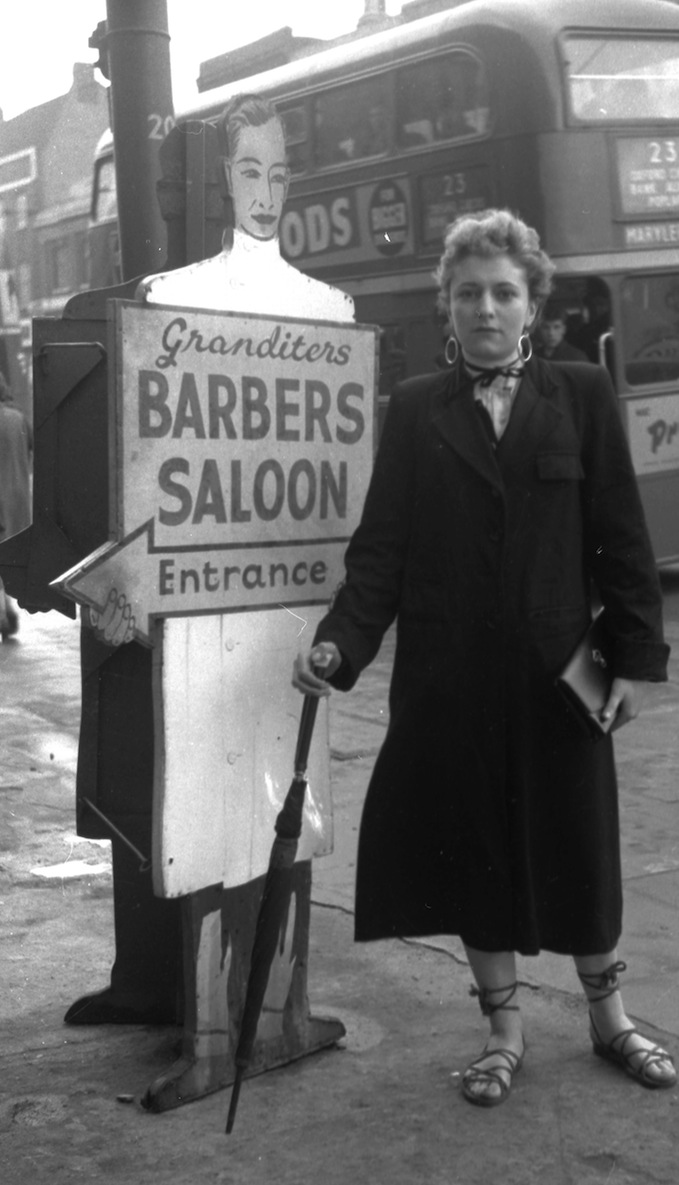
Pat Wiles outside Granditers on Rathbone Street Market
I was lucky my family could afford for me to have tailormade clothes, a lot of Teds couldn’t. All the jackets I had made were a finger tip drape. Two flap pockets on one side, one on the other. Velvet collar, vent up the back. One or two buttons. The long winter coat I am wearing was made from navy blue serge and had a navy blue velvet collar. Ken asked us to wear those lace up sandals. The photos were taken in January and we were absolutely freezing. He also instructed us not to smile, so we look really hard faced. Maybe he wanted to make us appear scary and intimidating.
In 1955, we listened to Frankie Laine, Johnny Ray, Tony Bennett, Doris Day. I had a Doris Day haircut, we used sugar water to stick little kiss curls onto our face. On the weekends I went out to the Winter Hall in East Ham on Saturday and on Sunday the Stratford Town Hall, the orchestras and big bands playing songs by Humphrey Lyttleton and Ted Heath.
My husband Brian and I have been going out since my sixteenth birthday. I was married at 21 and had my firstborn a year later. We have been married 53 years. All I wanted out of life was kids. We have four, I would have had another two if I had my way.
Grace Living
Grace Living: The captions that accompanied the photos in the Picture Post magazine article said I was 17, but I wasn’t I was 14 then. We used to go to the Docklands Settlement youth club and have a dance and coffee up there. I had a Saturday job in Levinsons, that was a blouse shop on Rathbone Street. My wage was a pound a day and I got a 50% discount. I remember buying a blouse for £4.99 which came with a little cameo brooch with it. I had black pencil skirts and black trousers too. I also had a shawl-collared jacket, mine was black with a yellow trim, drainpipe trousers, little ballet pumps, a clutch and clip on circle earrings. I used to make and customise things, stitch a rose onto a blouse or cover a clutch bag in a fabric to match your earrings. I’d paint my earrings with nail varnish to have them match your outfit. Clutch bags were an essential and they were cheap and cheerful. The ballet pumps were velveteen not leather.
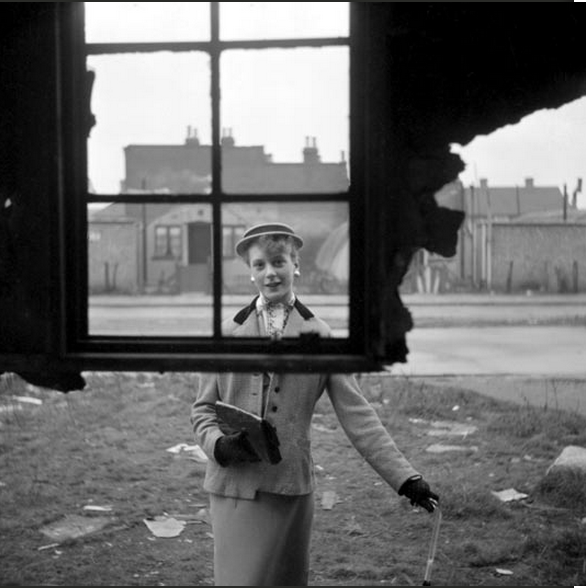
Barbara Wood
Me and my friends we all used to swap and share clothes. So you looked different every weekend. There wasn’t much money about. Clothing rationing only ended in 1954.
I left school a few months after these photos were taken. I did want to continue studying but you had to earn your keep in those days. I got an office job in High Holborn. About £2.25 a week wage then and I gave my mum £1.50 out of that for rent. I was the middle child of six, with 3 elder brothers and two younger sisters. We left the East end when we got married in 1960, I was 20, and moved to Barking and started a greengrocers. We have 3 daughters, four grandchildren and 3 step grandchildren.
All text copyright Eve Dawoud from interviews conducted by her for the research project Who Were the Teddy Girls?
Photos by Ken Russell except where noted
